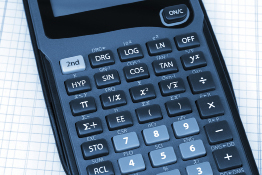Module 2
1. Module 2
1.12. Page 2
Module 2: The Imperial System
Get Started
In the last lesson you explored estimating answers to multiplication questions. You will remember that your estimation skills are important in seeing whether or not an answer given to a problem seems reasonable.
When working with units in the imperial system, you often multiply or divide by numbers that are difficult to handle mentally. Are there estimation techniques for division that make this task simpler?
The following example shows an estimation technique that relies on rounding each number to numbers that will easily divide into each other.
Example 1

iStockphoto/Thinkstock
Consider the following division question:
217 ÷ 27
Use your calculator. What is the answer to this question?
How could you estimate this answer without a calculator?
Solution
Begin by rounding 27 to one non-zero digit. What is this rounded value?
Next you should round the number being divided, 217, to two non-zero digits.
Why should you choose to round to two digits rather than one?
But the 2 in 200 is not divisible by the 3 in 30 a whole number of times. So instead, 217 is rounded to 210 because the 21 in 210 is divisible by the 3 in 30 a whole number of times.
Why wouldn’t you round 217 to 220 instead?
What is 21 ÷ 3?
What is 210 ÷ 30?
So, the estimated value of 217 ÷ 27 = 7, which is close to the value recorded from your calculator.
compatible numbers: numbers that are easy to use in a mental computation, especially division
You just used compatible numbers to estimate the answer to a division question.
For example, the numbers 21 and 3 are compatible numbers because 3 divides into 21 a whole number of times.
Example 2
Suppose the following numbers are to be used in a division. Which of the following numbers are compatible numbers?
- 32 and 7
- 15 and 5
- 44 and 11
- 40 and 6
Solution
- 7 does not divide into 32 a whole number of times, so these numbers are not compatible.
- 15 and 5 are compatible because 15 ÷ 5 = 3.
- 44 and 11 are compatible because 44 ÷ 11 = 4.
- 6 does not divide into 40 a whole number of times, so these numbers are not compatible.
 Self-Check
Self-Check
Respond to the following questions.
SC 1. Estimate 35 146 ÷ 41.
 Try This
Try This
Solve the following equations, first using estimation and then using calculation.
TT 1. 6700 ÷ 301 =
TT 2. 3758 ÷ 513 =
TT 3. 916 ÷ 22.7 =
TT 4. 81 070 ÷ 403.98 =
 Share
Share
It’s time to share your answers to TT 1–TT 4. Remember that sharing work is an important part of learning. As you discuss the Try This questions with a partner, think about the compatible numbers you used in the TT questions.
- Did your estimates differ from your partner’s estimates?
- Did you choose the same compatible numbers as your partner chose?
- Compare your estimates with the answers on a calculator.
- Why were some estimates closer to the calculated answers than others?
Revise your answers where necessary. Summarize your discussion by explaining how choosing different compatible numbers can lead to a variety of different estimates.
Save a revised copy of your work and a summary of your discussion in your course folder.
Now you should be ready to begin the Explore part of this lesson.